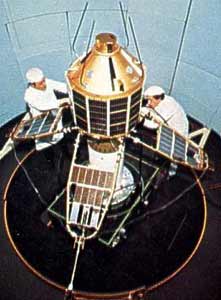 Ariel 4. | |
| Names | Ariel4, UK 4 |
|---|---|
| Mission type | Ionospheric |
| Operator | SERC / NASA |
| COSPAR ID | 1971-109A |
| SATCAT no. | 5675 |
| Mission duration | 1 year (design life) [1] |
| Spacecraft properties | |
| Manufacturer | BAC |
| Launch mass | 99.5 kilograms (219 lb) |
| Start of mission | |
| Launch date | 11 December 1971, 20:47:01 UTC |
| Rocket | Scout B-1-F S183C |
| Launch site | Vandenberg SLC-5 |
| Contractor | NASA |
| End of mission | |
| Decay date | 12 December 1978 |
| Orbital parameters | |
| Reference system | Geocentric |
| Regime | Low Earth |
| Eccentricity | 0.00795 |
| Perigee altitude | 473 kilometres (294 mi) |
| Apogee altitude | 590 kilometres (370 mi) |
| Inclination | 82.9 degrees |
| Period | 95.26 minutes |
| Epoch | 10 January 1972 [2] |
Ariel 4, known pre-launch as UK 4, was a British ionospheric research satellite, which was operated by the Science and Engineering Research Council. It was launched 11 December 1971, aboard an American Scout rocket. Experiments were designed to meet one scientific objective, making it the first mission-oriented satellite for the UK. It was also the first satellite in the Ariel programme to contain an American experiment. Ariel 4 decayed from orbit on 12 December 1978